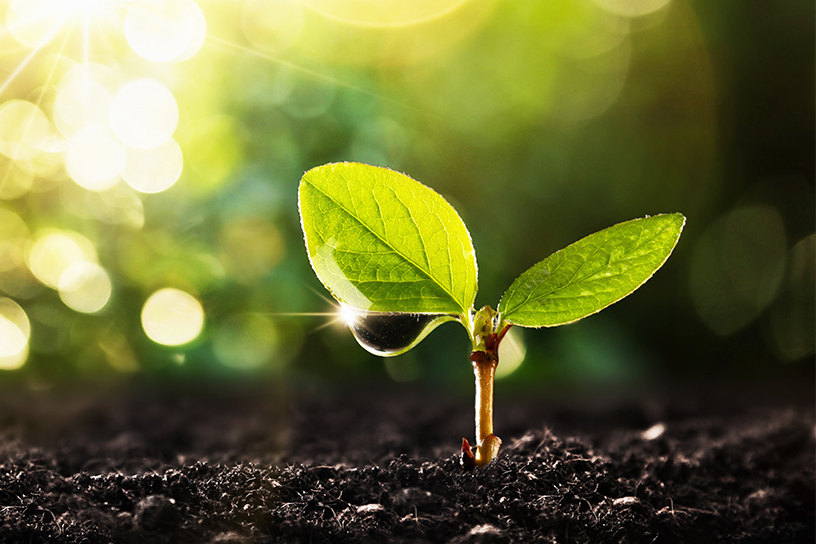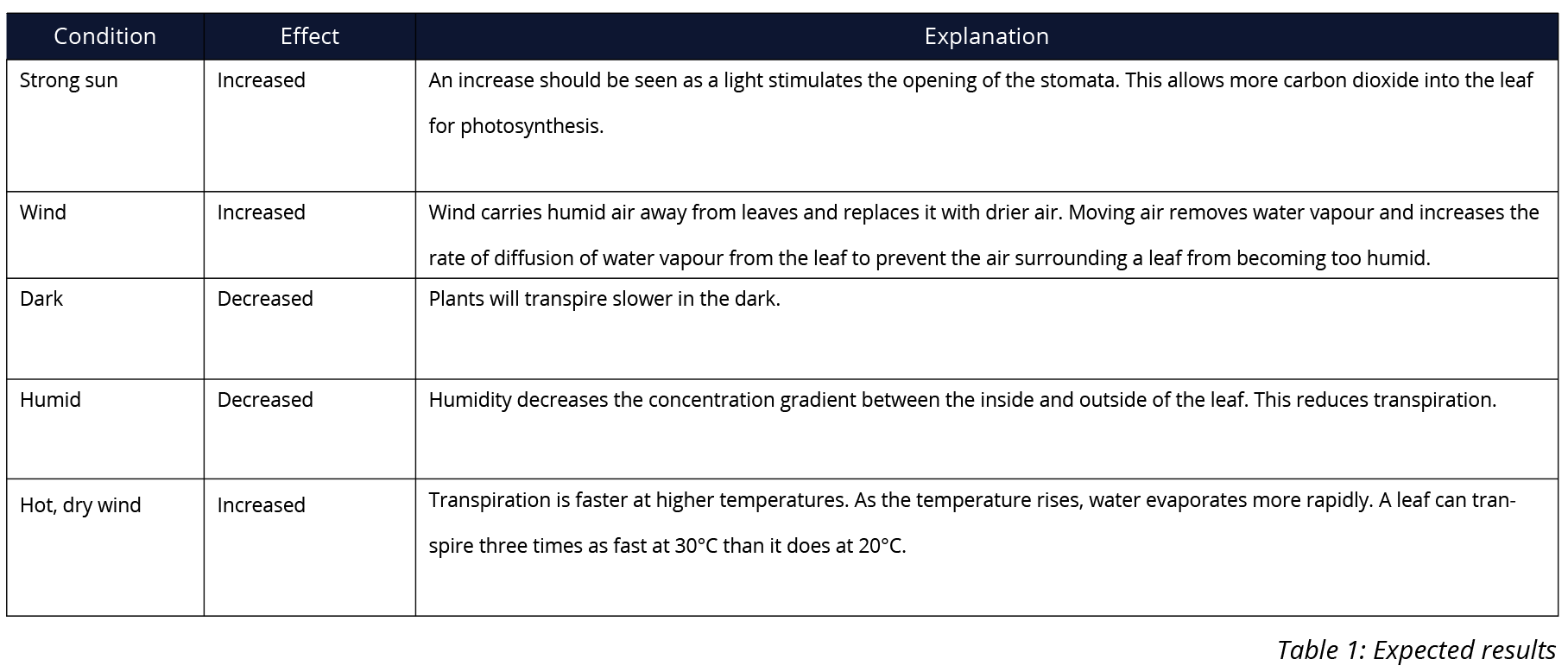Effects of Transpiration

AUSTRALIAN CURRICULUM ALIGNMENT
-
In plants, transport of water and mineral nutrients from the roots occurs via xylem involving root pressure, transpiration and cohesion of water molecules; transport of the products of photosynthesis and some mineral nutrients occurs by translocation in the phloem
BACKGROUND
Transpiration describes water loss from a plant as a result of evaporation from its surfaces. Transpiration rates are dependent on the rate by which water moves through a plant and how quickly water evaporation occurs on the surface of a plant and surrounding environmental conditions. Different species of plants transpire at different rates, based on the environmental conditions the plants evolved to survive in. For example, Xerophytes, thrive in very dry environments and have evolved to conserve water. Conversely, Hydrophytes are aquatic or semi-aquatic plants that thrive in very wet environments and have evolved to have a higher transpiration rate. The structures of the plant play a large role in transpiration rates. Transpiration occurs through a system of microscopic tubes, known as the vascular system that begin in the roots and extend through the stems, through to the leaves. Water is moved throughout the plant through the Phloem and Xylem. Water then reaches the Stomates which transport it onto the surface of the leaves where it will evaporate. Approximately 99% of the water absorbed by the roots does not take part in a plant’s metabolism and is transpired directly into the atmosphere. However, one percent of all water absorbed is enough to maintain the primary metabolic functions of the plant; such as photosynthesis and respiration.
In this investigation, students observe transpiration of a single plant species under various environmental conditions using a Potometer. To observe transpiration in action, students prepare a leafy root from a singular species, set-up a Potometer, place the leafy root within and place the apparatus within one of five designated environmental conditions that simulate they various conditions plants are exposed to. They simulate strong sun, wind, dark, humidity and a hot dry wind. Students then record the rate of transpiration by recording how far the bubble in the Potometer travels within ten minutes. Placing the near identical roots under different conditions within the class allows students an excellent opportunity to observe how the rate of transpiration is impacted by external factors.
PREPARATION - BY LAB TECHNICIAN
Collecting Samples-
Collect six fresh samples of root stems, enough for one per environmental condition and one control. The six shoots used should have a similar number of leaves that are approximately the same size. Any damaged or old leaves should be removed. Woody stems are best as they are easy to fit into the tubing or bung. We recommend using Geranium, Laurel or Privet.
- Ensure plant samples are free from insects or any potentially harmful chemicals by carefully washing them. Be aware of any plant allergies in the class prior to collecting plant samples & avoid collecting from plants that are known allergens.
Setting up a control
-
Following the same method as the student procedure, assemble the Potometer apparatus with a plant sample and place it under normal classroom conditions. Record how far the bubble moves within ten minutes and make these results available to students for comparison. Alternatively, you may like to demonstrate this technique in front of the class or instruct students to set up their own control.
Preparing Workstations
- Provide each student workstation with access to the following materials.
-
Potometer
- Small Beaker
- Scalpel
- 1 Leafy Shoot (e.g. Geranium, Laurel, Privet)
- Graph Paper
- Stop Watch
- Petroleum Jelly
- Container filled with water (for cutting plant stems)
- Each group requires different equipment depending on which condition they are measuring.
- Strong sun: Near a closed window or strong light source.
- Wind: Fan
- Dark: Box to cover equipment
- Humid: Clear plastic bag to contain equipment and seals
- Hot, dry wind: Warm air from a convection heater
METHOD - STUDENT ACTIVITY
Preparing the Potometer
-
Each class group will test a different environmental condition and share the results with the class. Your teacher will set up a control test under normal classroom conditions. You will use this control to measure whether an increase or decrease in transpiration rates occurred under your specific test conditions. Collect a plant shoot. The stem should be approximately the same diameter as the bore of the rubber tubing on the Potometer.
- Using a scalpel, cut through the stem at an angle of 45° while the stem is under water. Keep the stem in the water, but do not allow the leaves to become wet. Cutting under water will prevent the stem from being exposed to the air for too long.
- Fill a small beaker with water and place under the inverted end of the capillary tube. Release the screw clip to allow water to flow into the Potometer.
- Continue filling the Potometer until there are no longer any air bubbles and there is sufficient water in the bowl to cover the bottom of the capillary tube.
- To prevent further water flow from the reservoir, tighten the screw clip. Block the end of the tube that is immersed in the small bowl by holding your finger against it. Ensure there are no water leaks or air in the apparatus.
- Take the plant sample from the water and insert the cut stem into the rubber tubing of the vertical side arm. Ensure the cut stem is kept wet throughout to prevent desiccation. You may like to use petroleum jelly to create an extra seal around the plant and the tubing.
Observing Transpiration
-
Place the root and apparatus in one of the five environmental conditions.
- After a steady rate of transpiration is achieved, collect your stopwatch and record how far the bubble moves within ten minutes.
- Determine whether you observed an increase or decrease in transpiration based on the results of the control collected in ten minutes in normal room conditions..
- Share your results and fill in Table 1 with the class data.
OBSERVATION AND RESULTS
Below is an example of expected results. This is to be used as a guide only as individual results will vary.

INVESTIGATIONS
-
Challenge students to describe the relationship between water uptake and environmental conditions.
- Ask students to identify the steps that were taken to ensure that results were accurate.
EXTENSION EXERCISES
You may like to compare transpiration in different plant species; Xerophytes (Cactus, Oleander, Sage), Hydrophytes (Water lily, Pickerel Weed) and Mesophytes. Xerophytes thrive in very dry environments that other plants cannot. Towards the aim of conserving water, Xerophytes have a thicker waxy cuticle, Stomates recessed into crevices that open only at night, reduced leaf surface and hairy leaves (to reduce wind evaporation). Hydrophytes are aquatic or semi-aquatic plants that thrive in very wet environments. Without the need to carefully conserve water, these plants have reduced waxy cuticle, rapid transpiration rate and the ability to float to prevent water logging. Mesophytes thrive in moderate environmental conditions that are neither extremely dry nor extremely wet.
 Time Requirements
Time Requirements
- 50 mins
 Material List
Material List
- Potometer
- Small Beaker
- Scalpel
- 1 Leafy Shoots (e.g. Geranium, Laurel, Privet)
- Stop Watch
- Petroleum Jelly
- Container filled with water (for cutting plant stems)
- Each group requires different equipment depending on which condition they are measuring (Strong sun: Near a closed window or strong light source, Wind: Fan, Dark: Box to cover equipment, Humid: Clear plastic bag to contain equipment and seals, Hot, dry wind: Warm air from a convection heater)
 Safety Requirements
Safety Requirements
- Wear appropriate Personal Protective Equipment (PPE), including gloves and lab coat.
- The glass tubing in the Potometer can potentially break and cause injury. Exercise care and follow safe glass clean up procedure if breaking occurs.
- Fresh plant samples may contain allergens. Be aware of any plant allergies and wear gloves to prevent an allergic reaction.
- Take care when handling scalpels to prevent risk of injury.
